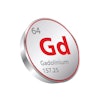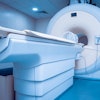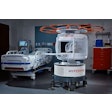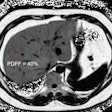Researchers at the University of Alabama at Birmingham (UAB) have found that the frequency of adverse reactions from the MRI contrast agent gadoteridol is similar to rates with other gadolinium-based contrast agents, according to a study published online January 19 in Radiology.
The contrast agent, marketed as ProHance by Bracco Diagnostics of Princeton, NJ, had an overall reaction rate of 0.666%, or 187 patients among the 28,078 in the study. Events reported included six moderate and four severe reactions.
With this information, the study's authors, led by Desiree Morgan, MD, UAB's vice chair of clinical research and director of MRI, hope to provide clinical guidance for radiologists trying to decide which agent among the various gadolinium-based contrast media is most applicable for a given patient's needs.
Approved agents
Currently, there are five gadolinium-based contrast agents with similar extracellular fluid biodistribution approved for clinical use by the U.S. Food and Drug Administration (FDA):
- Gadopentetate dimeglumine (Magnevist, Bayer HealthCare Pharmaceuticals, Wayne, NJ)
- Gadoteridol (ProHance)
- Gadodiamide (Omniscan, GE Healthcare, Chalfont St. Giles, U.K.)
- Gadoversetamide (Optimark, Covidien, Dublin)
- Gadobenate dimeglumine (MultiHance, Bracco)
In addition, gadoxetate disodium (Eovist, Bayer) and gadofosveset (Ablavar, Lantheus Medical Imaging, North Billerica, MA) also have FDA clearance specifically for liver and vascular imaging, respectively. These agents have more specialized vascular biodistribution.
Citing the ACR Manual on Contrast Media, the researchers noted that adverse events from gadolinium-based contrast agents occur at a rate of 0.07% to 2.4%. Most reactions are mild and include nausea, vomiting, headache, warmth or pain at the injection site, and dizziness. More severe anaphylactic reactions are much less common and occur 0.001% to 0.01% of the time.
NSF concern
A major concern is the association between gadolinium-based contrast agents and nephrogenic systemic fibrosis (NSF), a debilitating and sometimes fatal condition that can cause fibrosis of the bones, kidneys, lungs, muscles, and other structures. NSF is a serious health issue for patients with kidney problems who receive large doses of gadolinium-based contrast agents.
Morgan and colleagues wrote that in December 2006 their facility switched to a policy of selective gadoteridol use in some patients with chronic kidney disease because of concerns regarding NSF.
"Our decision to switch to gadoteridol as our primary gadolinium-based contrast medium in 2007 was based on concerns of patient safety with respect to relative risks of exposure to the various agents," they wrote. "These concerns have been raised [in previous research] and were supported by evidence that the risk for NSF in patients undergoing long-term hemodialysis may be lower in patients receiving gadoteridol than it is in patients receiving gadodiamide and gadopentetate dimeglumine."
The prospective study took place at UAB's 910-bed tertiary facility and affiliated clinic from July 2007 thought December 2009. Imaging was conducted on a total of six MRI units: one 1.5-tesla Signa Echospeed 15HDxt, one 1.5-tesla Signa Twinspeed 15HDxt, and two 1.5-tesla LX Echospeed units from GE Healthcare, along with 1.5-tesla and 3-tesla Intera Achieva systems from Philips Healthcare (Andover, MA).
The researchers collected and reviewed a total of 45,722 MRI exams from the 30-month time period and found that gadoteridol was administered intraveneously in 28,078 cases (61%).
Adverse reactions
Among those patients receiving gadoteridol, there were 229 reactions to gadoteridol among 187 patients (88 men, 99 women), for an overall adverse reaction rate of 0.666%. Of these patients, 177 (0.63%) experienced mild reactions, six (0.021%) had moderate reactions, and four (0.014%) had severe reactions.
(Since the paper was accepted for publication, the UAB study has increased its patient sample to approximately 40,000 cases. "Whereas before our overall reaction rate was 0.666%, it is now 0.626%," Morgan told AuntMinnie.com.)
Nausea, vomiting, itching, and urticaria were the most common reactions, and 27 patients required treatment for their adverse reactions.
In addition, 17 (9.6%) of the 177 patients with mild reactions received medical therapy, while 160 (90.4%) of the mild-reaction group required no treatment. Two patients experienced cardiopulmonary collapse and required resuscitation with standard advanced cardiac life support measures in the MRI suite. Seven patients were transferred to the emergency department.
Adverse reactions in patients receiving ProHance
|
||||||||||||||
| Source: Radiology and Desiree Morgan, MD |
"All four severe reactions were anaphylactoid," the authors noted. "Three of the four patients required medical intensive care unit admission; one was discharged from the emergency department after treatment and several hours of observation. There were no deaths."
Among the 4,134 patients who were scanned with a 3-tesla MRI system, half received a standard dose of gadoteridol as calculated by weight. Adverse reactions were seen in 26 patients (0.63%); 24 reactions (0.58%) were considered mild, with one reaction rated as moderate and one as severe.
Clinical practice
There are some exceptions to the facility's standard practice of administering gadoteridol. Patients with metastatic disease in the brain who are receiving Gamma Knife treatment and who have an estimated glomerular filtration rate (eGFR) of greater than 60 will receive Bracco's MultiHance agent due to its enhanced sensitivity to detect brain lesions. UAB also uses Bayer's Eovist to characterize focal hepatic lesions in patients whose eGFR is greater than 60.
"We do have other products we use for specific indications like that," Morgan added. "And, because there is some allergic reaction to all gadolinium products, we keep on board a couple of other brands to give in the case of a patient with normal renal function who has had some sort of reaction to ProHance. But 99.9% of our patients get ProHance."
The authors did cite several limitations of the study; for example, not all contrast reactions may have been recorded if they were mild and occurred after the typical 30 to 60 minutes of observation in the outpatient setting. Another limitation is that the authors did not track the occurrence of NSF, although they did note that of the 15 patients with NSF followed by UAB's dermatology clinic, none received intravenous gadoteridol.
| The authors of the study did not disclose any financial activities related to the present article. In activities not related to the present article, Morgan reported participating in an institutional grant from Bracco Diagnostics, while a co-author on the current study reported receiving grants from both Bracco and GE Healthcare. |
By Wayne Forrest
AuntMinnie.com staff writer
January 27, 2011
Related Reading
New FDA policy has changes for all gadolinium MRI agents, September 16, 2010
ACR tackles NSF risk in new gadolinium MRI contrast guidance, June 17, 2010
FDA panel: NSF incidence falls with gadolinium restrictions, December 9, 2009
Copyright © 2011 AuntMinnie.com


.fFmgij6Hin.png?auto=compress%2Cformat&fit=crop&h=100&q=70&w=100)





.fFmgij6Hin.png?auto=compress%2Cformat&fit=crop&h=167&q=70&w=250)











